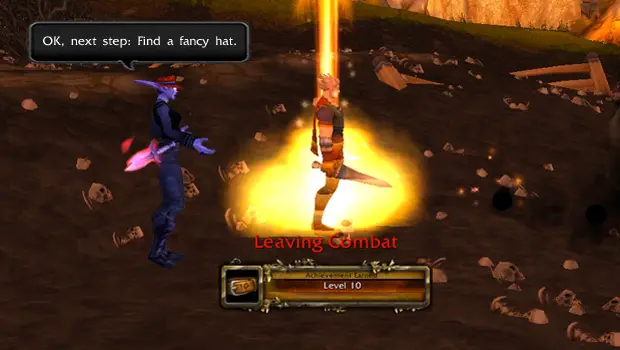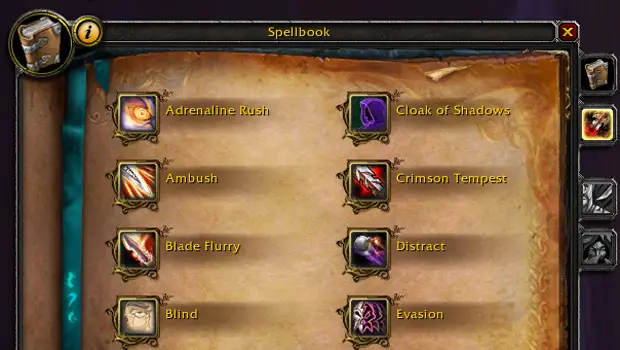Encrypted Text: Rogue leveling survival guide

You can feel it, deep down in your soul. A rumbling, a restlessness. A need to skulk, to steal; to slice your enemies into thin, perfectly proportioned ribbons. You’ve tried to delay — oh, how you’ve tried! — but you can’t deny your base instincts any longer.
The time has come to return to the shadows.
The time has come to level a rogue.
There’s only one catch: You don’t have a prayer of a clue how to do it.
Good thing there’s Blizzard Watch, eh?
To celebrate Encrypted Text’s emergence from stealth, I asked folks on Twitter what topic they’d be most interested in seeing me cover for our first column back. The winner … well, that’s probably kind of obvious by now.
Now, mind you, this is not meant to be a comprehensive walkthrough of everything you need to know about leveling a rogue. Other places on the Web already do that quite well. I’m just here to cover the big stuff, and lovingly toss some shurikens of advice at you along the way.
The Choices We Make
Your specialization. Whenever I see a person ask what rogue spec is “best” for leveling, my brain scrunches up. To me, the best way to choose a spec is to try each of them for a few levels, then if there’s one that feels the most fun to play, keep playing it. Any rogue spec can potentially be the “right” choice. For truly.
Here’s what I will say about how each spec feels to play:
- Assassination: Relies on hard-hitting abilities (Mutilate) and damage over time (poisons, bleeds); has the most “waiting” time between spell casts.
- Combat: Your best option if you love fighting multiple things at once (thanks to Blade Flurry) — but be careful you don’t bite off more than you can chew.
- Subtlety: The most active (read: lots of button presses) spec while leveling, thanks to soft but fast-hitting abilities (Hemorrhage and, once you hit Level 40, Backstab).
Your gear. When it comes to armor, rogues are all about leather with agility on it; when you’re leveling, no other stats really matter, and you don’t need to worry about gems or enchants (both because their impact will be small and because it’s a waste of gold/resources given how quickly you’ll upgrade to better gear).
Your weapons. For the most part, as a young rogue making their way in the world of murder and treachery, you’ll want to hew to these rules of the stabbing road:
- Assassination: One dagger in each hand. You literally can’t cast your primary damage spell (Mutilate) otherwise.
- Combat: A “slow weapon” (axe, fist weapon, mace or sword) in your main hand; either a dagger or a slow weapon in your off hand.
- Subtlety: Either a dagger or a slow weapon in each hand.
Keep your “better” weapon (usually the one that has the higher “damage per second” number in the tooltip) in your main hand.
Your talents and glyphs. There’s no such thing as a “required” leveling talent or glyph, but there are some that may prove more handy than others. Because this is just a survival guide, I won’t break recommendations down by level or glyph slot, but I will point out a few of my favorites.
- If you’re leveling by yourself, when you get to Level 45, I strongly recommend the Leeching Poison talent. It provides a reliable, low-level heal that ticks away in the background — and if you’re in trouble, you can cast Shiv on your target for a quick health infusion.
- At Level 60, choosing between Burst of Speed (BoS) and Shadowstep is always tough for me. I adore Burst of Speed paired with the Level 15 Nightstalker talent, because when I’m in stealth, I can cast BoS repeatedly to move as fast as a mounted player. But Shadowstep is tons of fun — you can even cast it on friendly players and critters to teleport to them!
- Glyph of Deadly Momentum is probably the most useful leveling glyph we’ve got. When you’re on a roll and you’re slicing your way through mob after mob, you can keep Slice and Dice (an important damage booster) and Recuperate (a decent, ticking self-heal) active almost indefinitely.
- Glyph of Safe Fall and Glyph of Blurred Speed are purely quality-of-life choices, but I love them both dearly. Their usefulness is deeply situational, obviously — but when those situations arise (e.g., “I’d like to swim to that island, but it’s so far …”), you’ll be so happy you picked them.
Study Your Spellbook
We unlock new spells as we level, so I don’t want to get too deeply into what every spell does and when to use it, because those recommendations change (and are different depending on whether you’re questing, PvPing, in dungeons, etc.). That said, very generally speaking …
Damage Spells:
- Assassination: Build combo points with Mutilate. Spend them on Envenom.
- Combat: Build combo points with Sinister Strike (and, at Level 20 and above, use Revealing Strike whenever you start smacking a new target). Spend them on Eviscerate.
- Subtlety: Build combo points with Hemorrhage (or, if you’re not in front of your target and at least Level 40, Backstab). Spend them on Eviscerate.
If you’re in stealth, Ambush is your hardest-hitting spell to use when you’re “opening” on your target. However, Garrote (which can silence a caster for a few seconds) and Cheap Shot (which stuns your enemy) can be fun and useful — although they won’t work on many elite mobs and bosses.
I also want to give a shout-out to Slice and Dice, the most powerful-yet-underrated weapon in a rogue’s arsenal. It costs combo points to use, but it’s basically a single button you press in order to increase your damage by roughly 40%. If you’re fighting anything likely to live more than a few seconds, it’s worth using (and refreshing with five combo points when the timer has just a handful of seconds left).
Utility Spells:
A rogue is as much about utility and defense as it is about offense, so get to know these additional spells as well (and consider putting a few of them on your action bar), and try them out periodically just for funsies:
- Interrupts and stuns: Blind, Gouge, Kick, Kidney Shot
- Damage avoidance: Cloak of Shadows, Evasion, Feint
- Survival aids: Recuperate, Vanish
Also, note that when you’re in stealth, your action bar is different from when you’re not in stealth. This means you can put a whole mess of stealth-specific spells on your stealth bar (such as Ambush, Cheap Shot and Sap) without worrying that they’ll clutter up your regular action bar.
Leveling the Rogue Way
With all that info out of the way, let’s talk about our feelings.
To me, the most important aspect of playing — and, more importantly, enjoying — a rogue in WoW is embracing its unique style. Unless you’ve spent time leveling a feral druid, no other class or spec in the game feels like a rogue.
To help you get in the mindspace of rogueness, remember these tips.
Know your resources. We use one set of abilities to generate combo points, then use another set of abilities to spend them — and both sets of abilities also cost energy, which prevents us from casting spells every single second and our fingers falling off.
You’re not a paladin. Rogues are not designed to tank all of the things. Abilities like Evasion and Combat Readiness can make us feel like a tank for several seconds, but generally speaking, you don’t want to spend a long time standing face-to-face with multiple enemies while they smack you repeatedly. A rogue works best when it’s dispatching one target at a time, gliding from one enemy to the next brutally and efficiently. If you get in over your head, Vanish.
Use your poisons. They expire every hour. Always remember to reapply them (they’re in your spellbook, and can be added to your action bar); they account for a large chunk of our damage and utility.
Be stealthy. Use it liberally. We move as quickly in stealth as we do outside of it (faster, even, with the Nightstalker talent). It doesn’t make us invisible or undetectable, but when used wisely, it can make many quests a ton easier by allowing you to skip mobs you’re not required to kill. Make it a habit to enter stealth as soon as you leave combat.
Control crowds. Use Sap when you’re approaching two NPCs to knock one out while you dispatch the other. Use Distract to make mobs face in a different direction so you can sneak behind them more easily. If you’re engaged in battle and a new enemy gets too close, click on it (or use the Tab key to target it) and cast Blind to keep it from attacking you, then resume murdering the mob at hand.
Be alert. When you’re playing solo (especially in Draenor), you’ll often find yourself going mano-a-mano with elite or high-health NPCs. Many of these mobs cast dangerous spells directly in front of them. Watch their cast bars and pay attention to where the spell is being aimed. In a pinch, you can run through your target to quickly get behind them. You can also interrupt some spells by casting Kick or Gouge, or by stunning the mob with Kidney Shot or Blind.
It’s OK to have fun. Pick an NPC’s pocket. Use your stealth to explore areas far above your experience level. If you’re on a PvP server, murder an enemy toon or two if they’re on your level (but be prepared for the possible ramifications). One of the things I love most about playing a rogue is the amount of flexibility and freedom it gives me to play the game the way I like. That playstyle may not be for you — but then again, it may be exactly what you’re looking for.
Got more questions? Survival guide not enough? Meet me in the comments — and give Aeriwen’s leveling FAQ in the official forums a read when you get the chance.
Please consider supporting our Patreon!
Join the Discussion
Blizzard Watch is a safe space for all readers. By leaving comments on this site you agree to follow our commenting and community guidelines.





